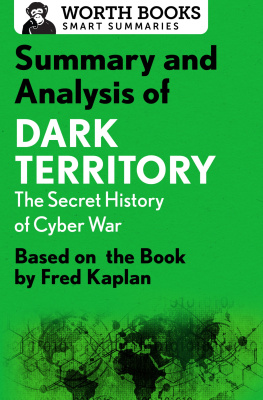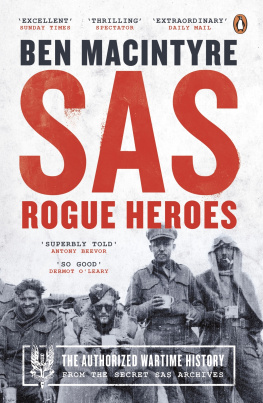Summary and Analysis of
Rogue Heroes
The History of the SAS, Britains Secret Special Forces Unit That Sabotaged the Nazis and Changed the Nature of War
Based on the Book by Ben Macintyre

Contents
Context
In the modern world, asymmetrical warfare and special forces are a military arsenals specialized dagger, a weapon honed over decades of evolution and refinement. US Navy SEALS, Delta Force, and the Green Berets are all the descendants of the British Special Air Service (SAS), a unit formed on a shoestring and a wild dream in the deserts of North Africa in the early days of World War II. These modern incarnations of the Special Warrior did not exist before mid-1941, when an iconoclastic British officer named David Stirling conceived a new kind of warfare and almost single-handedly created a fighting force that would change the rules of combat.
Rogue Heroes is the first book to examine the early days of Great Britains Special Air Service. It follows the unit from its birth in North Africa, harrowing the supply lines of the German Afrika Korps, to the invasion of Italy and finally of Germany itself. It details the lives and exploits of Stirling, and the men who built the SAS and nurtured it through its infancy into one of the most celebratedand effectivemilitary units in modern warfare. They fought, they died, they were captured, and they escaped to fight again. The descriptions of these men and their exploits form a portrait of the special-operations fighter that is valid even today.
Overview
At the height of World War II, Nazi Germany had driven Great Britain back onto its heels. The German Afrika Korps, led by Field Marshal Erwin Rommel, was sweeping across North Africa towards Egypt, driving British forces before them. France, Belgium, and Poland had already fallen. It was a war of great armies clashing on clear battlefields, as war had always been.
Into the middle of this traditional warfare came a young, visionary British officer named David Stirling, a gadabout with little respect for military traditions and ways of thinking, and little interest in chain-of-command and regular channels. As the Germans tore across North Africa, Stirling conceived a new way of striking the Germans, a way that lay far outside the bounds of conventional warfare. His idea was to send a small force of men parachuting behind enemy lines to harry and harass, disrupt and demoralize, and to sabotage airplanes and sever supply lines.
Partnered with the disciplined, hard-charging soldier Jock Lewes, Stirling convinced his superiors to give him a few men and a handful of supplies. He then proceeded to create a fighting force that would revolutionize the nature of modern warfarethe Special Air Service (SAS).
Working autonomously in a kind of half-organized free-for-all, Stirling and Lewes recruited a group of fighters who would become legendary for their exploitsand for their sacrifice. Despite failures and missteps, the SAS became a thorn in the side of the Afrika Korps, destroying planes, interdicting supply lines, providing intelligence, and becoming a noisy, distracting drain on German resources. The SAS was instrumental in turning the tide of the war in North Africa.
With victory in Africa complete, the SAS became the tip of the spear in the Allied invasion of Italy, France, and ultimately Germany. As the war claimed the SASs commanders, one by one, and the British top brass still did not know what to do with this new, unconventional fighting force, the SASs role evolved and fluctuatednot always in a way commensurate with Stirlings original visionand in those instances, always to the units detriment.
When forced to assume a more traditional commando role, the unit suffered needless losses. But through it all, there was a core of battle-hardened veterans that maintained unit cohesion and a unique camaraderie, and worked to bring its actions back in line with the original missionsmall units acting autonomously behind enemy lines.
Through these exploits, the author skillfully paints detailed psychological portraits of the men of the SAS: leaders, rogues, and warriors. They were studies in contradictions, fighting spirit, and immense personal courage. Their story is also one of the vicissitudes of war, of victories, wounds, and loss. A man could be a hero one day, and the next, killed in an ignominious accident, or taken prisoner for being in the wrong place at the wrong time.
As Macintyre states at the end of the book, In tactics and intentions, American and British special forces still follow the principles pioneered by the SAS in the desert more than seventy years ago: attacking the most valuable strategic targets without warning and then melting away again, forcing the enemy to remain on constant, debilitating alert. This is the legacy of the SAS.
Summary
Prologue: Into the Dark
In November 1941, L Detachment of the Special Air Service, the SAS, was on its first mission, known as Operation Squatter. Fifty-five soldiers of a new kind of military unit, a motley, patchwork crew, prepared to parachute at night into the Libyan desert with the goal of infiltrating five enemy airfields, planting explosives on as many German and Italian planes as possible, and then fading away toward a rendezvous point in the deep desert.
The weather for this mission was awful. Anti-aircraft batteries saw them coming and opened fire. The pilots lost sight of the drop zone. One by one they hurled themselves into the unknown.
Need to Know: Its going to be a dark, stormy ride.
Part I: War in the Desert
Chapter 1: Cowboy Soldier
In 1941, five months before Operation Squatter, Lieutenant David Stirling was in a Cairo hospital, paralyzed from the waist down by a botched parachute jump. While he regained the use of his legs, he had a lot of time to think about how poorly the war in North Africa was going for the Allies, and to imagine ways that he could improve the situation.
Stirling was known as a wastrel, a man who misbehaved on a lavish scale. He failed out of Cambridge twice, dreamed of climbing Mount Everest, and even went to America in 1938 to become a cowboy. When Britain went to war, he answered the call, but this did not increase his respect for convention. He regarded rules as nuisances to be ignored, broken, or otherwise overcome, and showed no deference to rank or tolerance for braggarts. Nevertheless, he possessed prodigious self-confidence. It was largely this self-confidence that inspired the formation of the SAS. He was a natural leader with unswerving faith in his own decisions.
In February 1941, he joined a unit of commandos called Layforce, and was sent to Scotland, and eventually Egypt. Stirling was eager for combat, but quickly tired of the tedium of training and preparation. He wanted in the fight, and he wanted it right now.
In the midst of a boredom-assuaging revelry in June, he had a conversation with Lieutenant Jock Lewes, a fellow officer who was as self-disciplined and uptight as Stirling was dissolute and nonchalant. Lewes had recently gotten hold of a stock of parachutes, and permission for an experimental jump in the desert. Mostly out of boredom, Stirling asked Lewes to show him how to parachute.
Need to Know: David Stirling was hardly a conventional soldier, but it was these traits that were perfect for his vision of a new kind of unit. Meeting Jock Lewes was the catalyst that made the formation of the SAS, and Operation Squatter, possible.
Chapter 2: L Detachment










